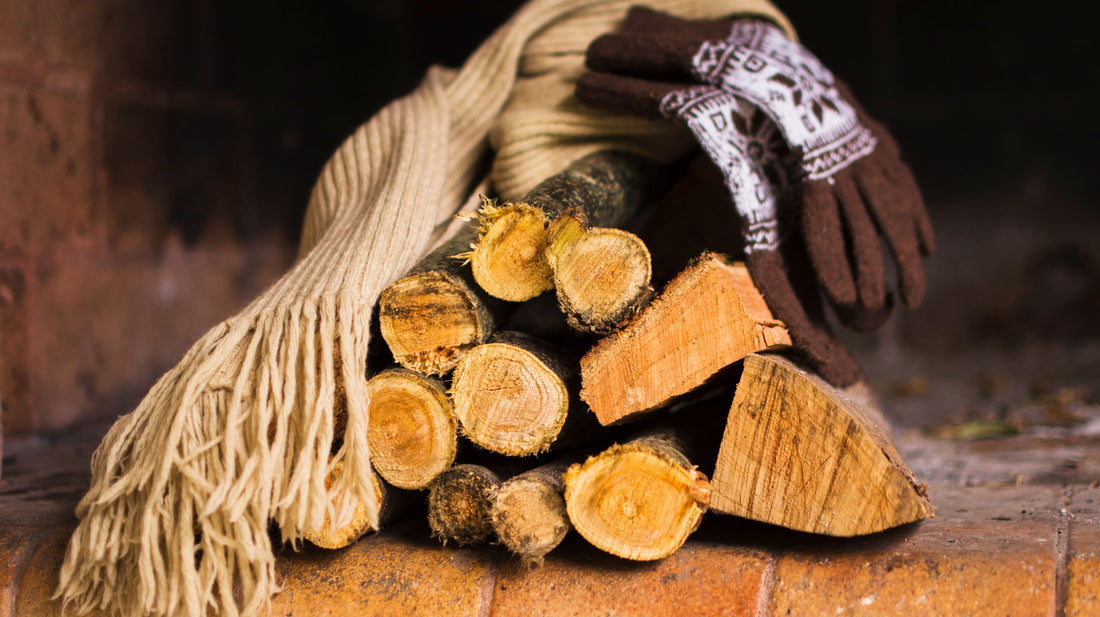
A perfect guide for future fireplace owners
Share
Making your own firewood - is it worth it?
Making your own firewood can be a rewarding experience, but it's important to consider several factors before deciding if it's worth the effort. Here are some key points to keep in mind:
1. Availability of resources: Do you have access to suitable sources of wood? Consider the availability of trees, the time and equipment needed to cut, split and dry the wood.
2. Time and Effort: Making firewood requires physical labor and time. Consider whether you have the necessary skills, tools and resources to complete the process effectively.
3. Cost savings: While making your own firewood can save money compared to buying it, consider the initial costs of equipment, fuel and maintenance. Calculate whether the long-term savings will make up for the initial investment.
4. Quality control: By making your own firewood, you can control the drying process and ensure optimal moisture content. This can lead to more efficient burns and reduced smoke emissions.
5. Sustainability: Harvesting your own firewood can be a sustainable practice if done responsibly. Consider the impact on local ecosystems and make sure you follow regulations on tree removal and land use.
Ultimately, whether making your own firewood is worth it depends on personal preference, available resources, and willingness to invest time and effort into the process.
When it's wet and cold outside, there's nothing better than a cozy fire with firewood. It's not just the special atmosphere that makes heating with firewood so attractive. Firewood is also a cost-effective alternative as a heating material in view of high gas prices. In addition, as a natural fuel, it burns in a CO2-neutral way.

Why choose wood?
Heating with wood offers numerous advantages that make it an excellent choice for future fireplace owners:
- Cost-effective : With gas prices rising, wood offers a more affordable option for heating your home.
- Cozy atmosphere : The crackling and warm embers of a fire create a cozy and inviting atmosphere.
- Carbon neutral : Unlike fossil fuels, burning wood does not contribute to the emission of greenhouse gases, making it an environmentally friendly choice.
Types of firewood
Not all firewood is the same. Different types of wood have different burning properties and heat output. Here are some common types of firewood to consider:
1. Hardwoods
Hardwoods are characterized by their dense structure, slow burning, and high heat output. Some popular hardwood options include:
- Oak
- Hornbeam
- Ash
- Red oak
- Maple
- Birch
- Beech
2. Softwoods
Softwoods ignite quickly and are ideal for starting fires or maintaining a consistent flame. Although they don't produce as much heat as hardwoods, they are readily available and easier to split. Common softwoods include:
- Jaw
- Spruce
- Fir
- Cedar
The right choice of firewood

To ensure optimal performance and safety, it is important to choose the right firewood for your fireplace. When choosing firewood, consider the following factors:
- Moisture content : Dry firewood burns more efficiently and produces less smoke. Aim for a moisture content of around 10-15%.
- Wood density : Hardwoods with high density offer longer burn times and higher heat output.
- Seasoned vs. fresh wood : Seasoned firewood has been dried for at least six months, making it easier to light and reducing the risk of soot buildup.
- Kiln-dried firewood: the best quality you can get.
Kiln-dried firewood has several advantages over seasoned firewood.

The advantages of kiln dried firewood are as follows:
- Lower moisture content: Kiln dried firewood has a moisture content of about 10-18%, compared to 20-30% for seasoned firewood, resulting in more efficient combustion.
- Immediate use: It can be used immediately after purchase without additional drying time.
- Less smoke: Produces less smoke and soot, resulting in less soot buildup and less chimney maintenance.
- Pest-free: The kiln drying process kills pests and mold, ensuring cleaner storage and handling.
- Higher heat output: Burns hotter due to lower moisture content and provides better heating performance.
A detailed comparison of the advantages and disadvantages of firewood: oak, hornbeam, ash, red beech, birch and beech:
1. Oak
Advantages:
- High Density: Oak is a very dense hardwood that burns slowly and produces a long lasting fire.
- High heat output: Generates a significant amount of heat, making it ideal for heating.
- Low smoke: Burns cleanly with minimal smoke.
- Good ember formation: Produces excellent embers, ideal for overnight burning.
Disadvantages:
- Long drying time: Requires a long drying time (up to two years) to dry properly.
- Difficult to split: Due to its density, it can be difficult to split.
- Availability: Depending on the region, it may be more expensive and harder to find.
2. Hornbeam
Advantages:
- High heat output: Known for producing a very large amount of heat.
- Long burning time: Due to its density, it burns slowly.
- Good ember formation: Produces high quality embers.
Disadvantages:
- Slow maturation: Requires a longer maturation time, similar to oak.
- Difficult to split: Very dense and can be difficult to split.
3. Ash
Advantages:
- Moderate density: Burns well and provides a good amount of heat.
- Fast maturing: Matures faster than most hardwoods, sometimes as little as six months.
- Easy to split: Generally easy to split by hand.
Disadvantages:
- Medium burning time: Does not burn as long as denser woods such as oak or hornbeam.
- Medium smoke: Can produce more smoke compared to oak or hornbeam.
4. Red oak
Advantages:
- High heat output: Delivers a significant amount of heat.
- Good ember formation: Forms high-quality embers.
- Widely available: More widely available in many regions.
Disadvantages:
- Slow ripening: Takes a long time to ripen properly, similar to other oak species.
- High moisture content: May have high moisture content when freshly harvested and requires extensive drying time.
- Heavy smoke: Can produce heavy smoke if not fully aged.
5. Maple
Advantages:
- High heat output: Generates a good amount of heat.
- Moderate ripening time: Matures faster than oak, but longer than birch.
- Easy to split: Generally easy to split and handle.
Disadvantages:
- Medium burning time: Does not burn as long as denser woods such as oak or hornbeam.
- Medium smoke: May produce moderate smoke.
6. Birch
Advantages:
- Fast ignition: Burns easily and quickly.
- Aromatic: Produces a pleasant smell when burned.
- Moderate heat output: Provides a reasonable amount of heat.
Disadvantages:
- Short burning time: Burns faster than denser woods and requires more frequent refilling.
- High smoke: Can produce more smoke compared to hardwoods like oak or ash.
- Resin content: High resin content can lead to soot deposits in chimneys.
7. Beech
Advantages:
- High heat output: Generates a significant amount of heat.
- Good ember formation: Produces excellent embers for a long lasting fire.
- Moderate drying time: Dries in a reasonable time, usually within a year.
Disadvantages:
- Difficult to split: Can be challenging, especially when wet.
- Moderate Smoke: Can produce more smoke than some other hardwoods.
Summary table
| Wood type | Heat output | Burning time | Drying time | Cleavage | Smoke development | Special features |
|---|---|---|---|---|---|---|
| Oak | High | Long | Long | Difficult | Small amount | Excellent embers |
| Hornbeam | Very high | Long | Long | Very difficult | Small amount | Excellent embers |
| Ash | Medium | Medium | Short | Simply | Medium | Fast drying |
| Red oak | High | Long | Long | Medium | High | Widespread |
| Maple | High | Medium | Medium | Simply | Medium | Moderate drying |
| Birch | Medium | Short | Short | Simply | High | Aromatic, quick ignition |
| Beech | High | Long | Medium | Difficult | Medium | Good embers |
Choosing the right type of firewood depends on your specific needs, such as heat output, handling, and availability. Each type has its own advantages and disadvantages, so you should consider these factors when choosing firewood for your purposes.
Making your own firewood - is it worth it?
Making your own firewood can be a rewarding experience, but it's important to consider several factors before deciding if it's worth the effort. Here are some key points to consider:
1. Availability of resources: Do you have access to suitable sources of wood? Consider the availability of trees, the time and equipment required to cut, split and dry the wood.
2. Time and Effort: Making firewood requires physical labor and time. Consider whether you have the necessary skills, tools and resources to complete the process effectively.
3. Cost savings: While making your own firewood can save money compared to buying it, consider the initial costs of equipment, fuel and maintenance. Calculate whether the long-term savings will pay off against the initial investment.
4. Quality control: By producing your own firewood, you can control the drying process and ensure optimal moisture content. This can lead to more efficient burns and reduced smoke emissions.
5. Sustainability: Harvesting your own firewood can be a sustainable practice if done responsibly. Consider the impact on local ecosystems and make sure you follow regulations on tree removal and land use.
Ultimately, whether it is worth making your own firewood depends on personal preference, available resources, and willingness to invest time and effort into the process.

Storing firewood
Proper storage of firewood is crucial to maintain its quality and ensure effective burning. Follow these tips for storing firewood:
- Raise the logs: Store the firewood on a raised surface to avoid moisture absorption and to ensure air circulation.
- Covering: Protect the firewood from rain and snow by covering it with a tarp or storing it in a shed.
- Ventilation: Ensure good ventilation to prevent mold growth by stacking the wood loosely.
Safety precautions
Although fireplaces provide warmth and comfort, it is important to put safety first. Follow these precautions when using your fireplace:
"Safety first! Follow these guidelines to ensure a worry-free experience."
- Chimney Maintenance : Inspect and clean your chimney regularly to prevent soot buildup and avoid possible chimney fires.
- Proper Ventilation : Before lighting a fire, ensure proper air circulation by opening the fireplace opener.
- Fireplace Screen : Use a fireplace screen or glass doors to prevent sparks from escaping.
- Distance from flammable objects : Maintain a safe distance between your fireplace and flammable materials such as curtains or furniture.
Conclusion
Owning a fireplace can enhance the ambiance of your home while providing an affordable heating option. By choosing the right firewood, using proper storage techniques, and following safety measures, you can enjoy the cozy warmth of a fire while minimizing your environmental impact. Stay warm and enjoy the many benefits of wood heating!
